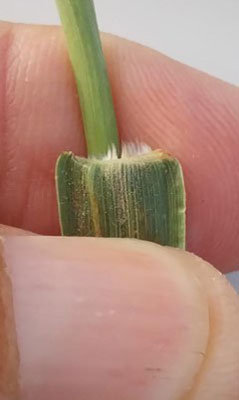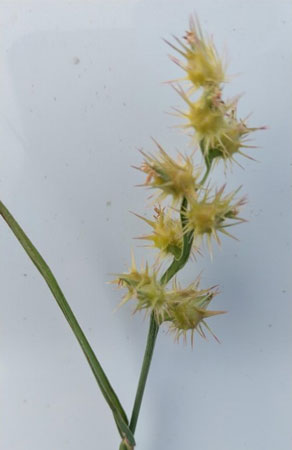This World of Weeds feature is longspine sandbur, sometimes called mat sandbur or grassy sandbur. As the name implies, this grass produces seeds in spiny burs. The burs quickly attach to anything contacting the mature plants, such as animal fur, vehicle tires, or human clothing and skin, enabling distribution.
Ecology
Longspine sandbur (Cenchrus longspinus) is a native annual species found throughout the United States. Its range extends from the southern Canadian provinces south into northern parts of South America. The plant has also become naturalized in parts of Europe, Africa, and Australia. It grows in disturbed areas, including cultivated fields, roadsides, field edges, and farmsteads. The plant not only competes with desirable plants for resources, but its nuisance factor ranks among the worst of plants. It is listed as a noxious weed in some areas of the U. S. Full-season interference from sandbur has been shown to reduce corn yields by up to 35%.2 Livestock will not utilize the mature plants due to mouth and nose injuries caused by the burs.
Identification
Longspine sandbur is a tufted, decumbent (lying flat to the ground with ends that turn upwards) plant that often forms a mat (Figure 1). In the Central Great Plains, sandbur normally emerges in late May through late June.1 The base of the stems is often reddish-purple and flattened. Stems are generally hairless and grow to a length of 36 inches. Leaves may reach 8 inches long and 0.25 inches wide, generally have a rough feeling on the upper surface, and are folded near the base (next to the stem). The ligule is a short tuft of hair (Figure 2).

Figure 1. A mat of Longspine sandbur near the edge of a sorghum field. Photo by Patrick Geier, K-State Research and Extension.

Figure 2. Hairy ligule of Longspine Sandbur. Photo by Patrick Geier, K-State Research and Extension.
The panicle of burs at the end of each stem is the most conspicuous identifier of the species. Panicles contain up to 30 burs, with each bur containing 1 to 3 seeds (Figure 3). Seeds typically germinate from within the burs, and the burs can often be found clinging to seedling plants when pulled from the soil. Longspine sandbur burs may have 40 to 75 spines each.2

Figure 3. Burs attached to the panicle of Longspine sandbur. Note the zig-zag appearance of the center rachis. Photo by Patrick Geier, K-State Research and Extension.
Management
In corn and sorghum, preemergence herbicides such as Group 5 (atrazine, etc.) and Group 15 (S-metolachlor, etc.) provide fair to good control of this late-emerging weed. A good corn stand will aid suppression since sandbur emerges later than many grasses. However, postemergence control options are more limited. Glyphosate (Group 9) is very effective at controlling sandbur in glyphosate-resistant corn. Glufosinate (Liberty, etc.) in glufosinate-resistant corn and Group 2 herbicides such as Accent are somewhat less effective. In sorghum, postemergence herbicides are only used in herbicide-resistant varieties Double Team (FirstAct herbicide), Igrowth (ImiFlex herbicide), and Inzen (Zest herbicide). Sandbur pressure may be reduced by delaying sorghum planting until the first flush of sandbur can be controlled using tillage or a nonselective herbicide. Though not 100% effective, a strong preemergence herbicide in sorghum that includes atrazine and a Group 15 herbicide will also help reduce sandbur competition.
Sandbur management in broadleaf crops such as soybean, sunflower, and cotton is somewhat easier. In addition to starting clean, applying a good foundation herbicide at planting, and the option to use herbicide-resistant varieties, these crops allow the use of group 1 herbicides postemergence. These herbicides, which include quizalofop (Assure II, etc.), clethodim (Select, etc.), and sethoxydim (Poast Plus), selectively target grass weeds. All are very effective at controlling longspine sandbur when used according to label directions.
References
1 Anderson, R. L. 1997. Longspine sandbur (Cenchrus longspinus) ecology and interference in irrigated corn (Zea mays). Weed Technol. 11:667-671.
2 Sustainable Agricultural Research and Education. https://www.sare.org/publications/manage-weeds-on-your-farm/sandburs/. Accessed September 12, 2024.
Patrick Geier, Weed Scientist, Garden City
pgeier@ksu.edu
Jeanne Falk Jones, Multi-County Agronomist, Colby
jfalkjones@ksu.edu
Sarah Lancaster, Extension Weed Management Specialist
slancaster@ksu.edu
Tags: World of Weeds sandbur